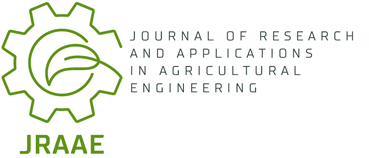Current issue
Online First
Archive
Instructions for Authors
Guide for Authors
Peer Review Policy
Research Ethics Policy
Crossmark Policy
Ghostwriting and Guest Authorship
Copyright
Open Access Policy
Plagiarism
About the Journal
Aim and Scope
Scientific Board
Publisher
Editorial Board
Indexing in Databases
Personal Data Protection
Repository Policy
Contact
ORIGINAL PAPER
The use of artificial intelligence methods for optimization of tractive properties on silty clay loam
1
Instytut Inżynierii Rolniczej Uniwersytet Przyrodniczy we Wrocławiu 51-630 Wrocław, ul. J. Chełmońskiego 37/41, Poland
Journal of Research and Applications in Agricultural Engineering 2018;63(1):63-68
KEYWORDS
ABSTRACT
The aim of this study was to develop valuable model of the interaction between low-power tractors wheel and deformed ground as well as to optimize tractor performance on silty clay loam. The relationships between traction force as well as traction efficiency and soil moisture, soil compaction, horizontal deformation, and vertical load were the subject of investigation. The research was carried out in the laboratory conditions. The two soft computing techniques of mathematical modeling were used: multilayer perceptron and radial basis function neural network. The more efficient model was obtained by multilayer perceptron. For the model with traction force as the output parameter the coefficient of determination was equal to 0,963 (MLP model) and 0,907 (RBF model). For the model with traction efficiency as the output parameter the coefficient of determination was equal to 0,986 and 0,944, respectively. Using the MLP model, the sensitivity analysis was conducted. The highest relative influence on traction force was observed for vertical load, in the case of traction efficiency, horizontal deformation is the most important parameter. For both dependent variables the lowest influence was calculated for soil compaction. The optimization of tractive properties requires generally high horizontal deformation, average soil moisture and high soil compaction. High vertical load is necessary for traction force maximization and relatively low for traction efficiency optimization.
REFERENCES (12)
1.
Smerda T., Cupera J.: Tire inflation and its influence on drawbar characteristics and performance - Energetic indicators of a tractor set. Journal of Terramechanics, 2010, 47: 395-400.
2.
Janulevicius A., Damanauskas V.: How to select air pressures in the tires of MFWD (mechanical front-wheel drive) tractor to minimize fuel consumption for the case of reasonable wheel slip. Energy, 2015, 90: 691-700.
3.
Lee J.H., Gard K.: Vehicle-soil interaction: Testing, modeling, calibration and validation. Journal of Terramechanics, 2014, 52: 9-21.
4.
Taghavifar H., Mardani A., Karim-Maslak H.: Multi-criteria optimization model to investigate the energy waste of off-road vehicles utilizing soil bin facility. Energy, 2014, 73: 762-770.
5.
Tiwari V.K., Pandey K.P., Pranav P.K.: A review on traction prediction equations. Journal of Terramechanics, 2010, 47: 191-199.
6.
Roul A.K., Raheman H., Pansare M.S., Machavaram, R.: Predicting the draught requirement of tillage implements in sandy clay loam soil using an artificial neural network. Biosystems Engineering, 2009, 104(4): 476-485.
7.
Carman K.: Prediction of soil compaction under pneumatic tires a using fuzzy logic approach. Journal of Terramechanics, 2008, 45: 103-108.
8.
Pentoś K., Pieczarka K.: Applying an artificial neural network approach to the analysis of tractive properties in changing soil conditions. Soil & Tillage Research, 2017, 165: 113-120.
9.
Pentoś K.: The methods of extracting the contribution of variables in artificial neural network models – Comparison of inherent instability. Computers and Electronics in Agriculture, 2016, 127: 141-146.
10.
Gajewski J., Valis D.: The determination of combustion engine condition and reliability using oil analysis by MLP and RBF neural networks. Tribology International, 2017, 115: 557-572.
11.
Bagheri V., Uromeihy A., Razifard M.: Evaluation of MLP and RBF Methods for Hazard Zonation of Landslides Triggered by the Twin Ahar-Varzeghan Earthquakes. Geotechnical and Geological Engineering, 2017, 35: 2163-2190.
12.
Taghavifar H., Mardani A.: Applying a supervised ANN (artificial neural network) approach to the prognostication of driven wheel energy efficiency indices. Energy, 2014, 68: 651-657.
Share
RELATED ARTICLE
We process personal data collected when visiting the website. The function of obtaining information about users and their behavior is carried out by voluntarily entered information in forms and saving cookies in end devices. Data, including cookies, are used to provide services, improve the user experience and to analyze the traffic in accordance with the Privacy policy. Data are also collected and processed by Google Analytics tool (more).
You can change cookies settings in your browser. Restricted use of cookies in the browser configuration may affect some functionalities of the website.
You can change cookies settings in your browser. Restricted use of cookies in the browser configuration may affect some functionalities of the website.


